Serving 375 students in grades Kindergarten-4, Meadowview School ranks in the top 10% of all schools in Illinois for overall test scores (math proficiency is top 20%, and reading proficiency is top 20%).
The percentage of students achieving proficiency in math is 40-44% (which is higher than the Illinois state average of 28%). The percentage of students achieving proficiency in reading/language arts is 55-59% (which is higher than the Illinois state average of 30%).
The student:teacher ratio of 11:1 is lower than the Illinois state level of 13:1.
Minority enrollment is 44% of the student body (majority Hispanic), which is lower than the Illinois state average of 55% (majority Hispanic).
Quick Stats (2025)
- Grades: Kindergarten-4
- Enrollment: 375 students
- Student:Teacher Ratio: 11:1
- Minority Enrollment: 44%
- Overall Testing Rank: Top 10% in IL
- Math Proficiency: 40-44% (Top 20%)
- Reading Proficiency: 55-59% (Top 10%)
- Source: National Center for Education Statistics (NCES), IL Dept. of Education
Top Rankings
Meadowview School ranks among the top 20% of public schools in Illinois for:
Category
Attribute
Overall Rank
Math Proficiency
Reading/Language Arts Proficiency
School Overview
Meadowview School's student population of 375 students has grown by 15% over five school years.
The teacher population of 33 teachers has grown by 37% over five school years.
Grades Offered
Grades Kindergarten-4
Total Students
375 students

Gender %

Total Classroom Teachers
33 teachers
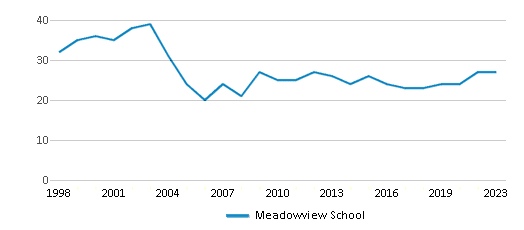
Students by Grade
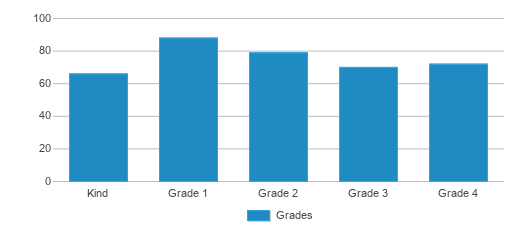
School Rankings
Meadowview School ranks within the top 10% of all 3,426 schools in Illinois (based off of combined math and reading proficiency testing data).
The diversity score of Meadowview School is 0.63, which is less than the diversity score at state average of 0.70. The school's diversity has stayed relatively flat over five school years.
Overall Testing Rank
#315 out of 3426 schools
(Top 10%)
(Top 10%)
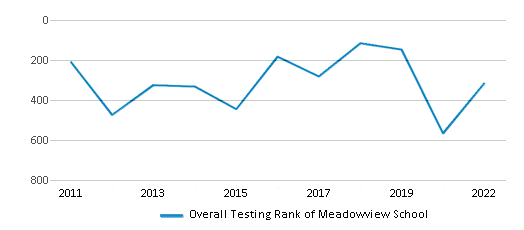
Math Test Scores (% Proficient)
(20-21)40-44%
28%
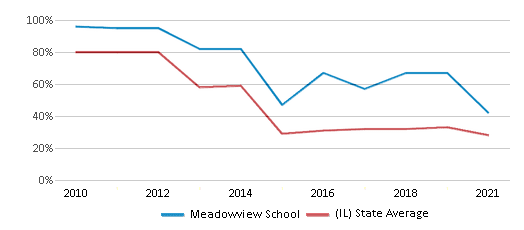
Reading/Language Arts Test Scores (% Proficient)
55-59%
30%
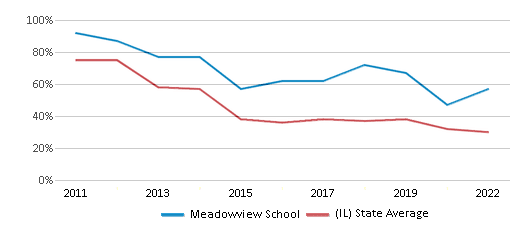
Student : Teacher Ratio
11:1
13:1
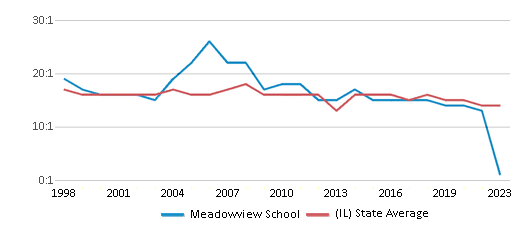
American Indian
n/a
1%
Asian
7%
6%
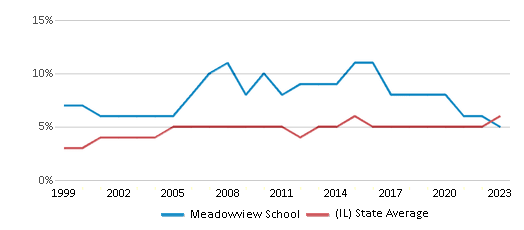
Hispanic
23%
28%
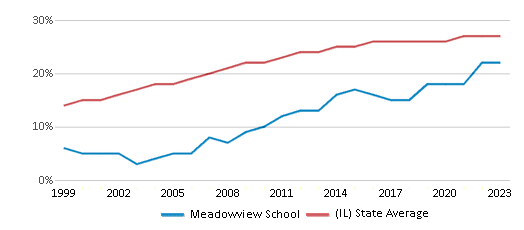
Black
7%
16%
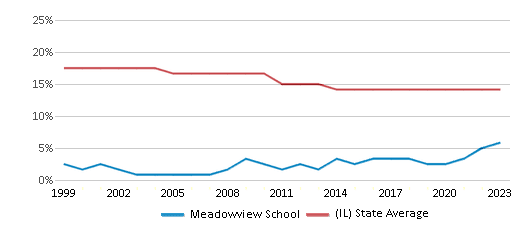
White
56%
45%
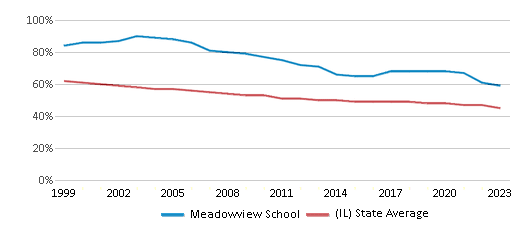
Hawaiian
n/a
n/a
Two or more races
7%
4%
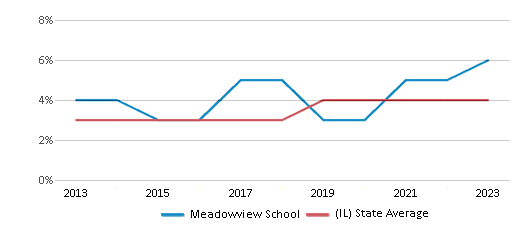
All Ethnic Groups

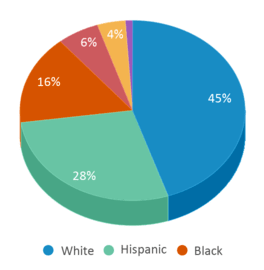
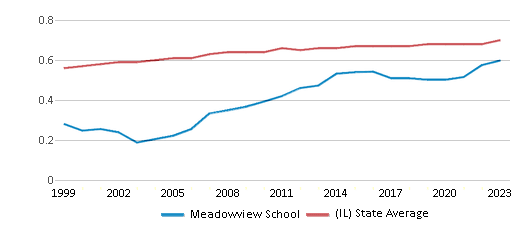
Eligible for Free Lunch
14%
43%
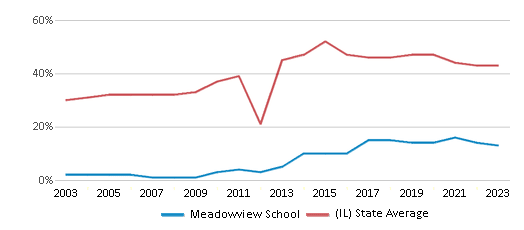
Eligible for Reduced Lunch
3%
4%
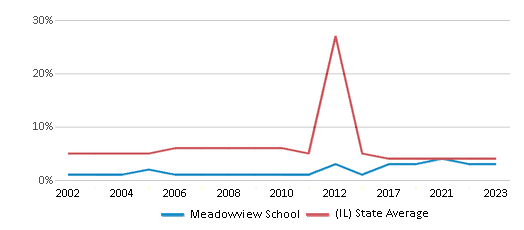
School Statewide Testing
School District Name
Source: National Center for Education Statistics (NCES), IL Dept. of Education
Profile last updated: 02/09/2025
Frequently Asked Questions
What is Meadowview School's ranking?
Meadowview School is ranked #315 out of 3,426 schools, which ranks it among the top 10% of public schools in Illinois.
What schools are Meadowview School often compared to?
Meadowview Schoolis often viewed alongside schools like Prairieview School, Prairie Crossing Charter School by visitors of our site.
What percent of students have achieved state testing proficiency in math and reading?
40-44% of students have achieved math proficiency (compared to the 28% IL state average), while 55-59% of students have achieved reading proficiency (compared to the 30% IL state average).
How many students attend Meadowview School?
375 students attend Meadowview School.
What is the racial composition of the student body?
56% of Meadowview School students are White, 23% of students are Hispanic, 7% of students are Asian, 7% of students are Black, and 7% of students are Two or more races.
What is the student:teacher ratio of Meadowview School?
Meadowview School has a student ration of 11:1, which is lower than the Illinois state average of 13:1.
What grades does Meadowview School offer ?
Meadowview School offers enrollment in grades Kindergarten-4
What school district is Meadowview School part of?
Meadowview School is part of Grayslake CCSD 46 School District.
School Reviews
5 8/20/2012
Our oldest son is about to enter into the fifth grade and Meadowview Elementary has been hands down the best school we''ve had the privilege of enrolling him into. We moved from California to Illinois halfway into the school year and the office staff were so welcoming and made it very easy for us to enroll him. His fourth grade teacher, Mrs. Fahrner was such an incredible blessing and helped to make his transition from one school to to another mid-year as easy as possible for him. Plus her communication with the parents of every child in her class was outstanding! The school also has a great music program, a wonderful campus, and was a truly great school for our son to attend. We are sorry that it does not go beyond fourth grade! They quality of the way the school is structured and run, made us feel like we placed our child in private school (and we can compare since private schools were all our children have been in while we lived in California). Great community, fabulous school.
Review Meadowview School. Reviews should be a few sentences in length. Please include any comments on:
- Quality of academic programs, teachers, and facilities
- Availability of music, art, sports and other extracurricular activities
Recent Articles

What Is A Charter School?
Explore the world of charter schools in this comprehensive guide. Learn about their history, how they operate, and the pros and cons of this educational innovation. Discover key facts about charter schools, including admission policies, demographics, and funding, as well as what to look for when considering a charter school for your child.

10 Reasons Why High School Sports Benefit Students
Discover the 10 compelling reasons why high school sports are beneficial for students. This comprehensive article explores how athletics enhance academic performance, foster personal growth, and develop crucial life skills. From improved fitness and time management to leadership development and community representation, learn why participating in high school sports can be a game-changer for students' overall success and well-being.

February 05, 2025
Understanding the U.S. Department of Education: Structure, Impact, and EvolutionWe explore how the Department of Education shapes American education, from its cabinet-level leadership to its impact on millions of students, written for general audiences seeking clarity on this vital institution.





